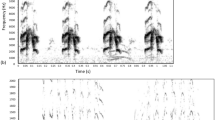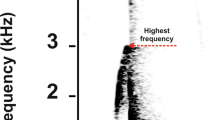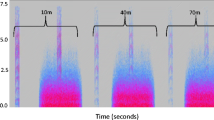Abstract
The pre-fledging survival of Greylag goslings (Anser anser) is known to be influenced by parenting style and particularly parental vigilance. Visual and acoustic cues may be important in parental vigilance: if vision is blocked, for example in a highly structured habitat, acoustic recognition of the goslings by their parents would be beneficial. We confronted parental and non-parental Greylag Geese with playbacks of gosling distress calls and analyzed their behavioral responses. Parental geese showed a significant increase in their vigilance behavior during and after playbacks while geese without offspring showed increased comfort behavior. In a permutated discriminant function analysis, we found no family-specific vocal cues in gosling calls, and potential call familiarity did not have any effect on parental behavioral responses. Vigilance in families was further influenced by the number of goslings and gosling age, with increased vigilance when the number of goslings was high, and when goslings were younger. Parental females were more vigilant than parental males, suggesting differences in parental investment between males and females. We conclude that visual cues may be more important in offspring-related vigilance than calls, which elicited different behavioral responses depending on the social class of the geese.
Zusammenfassung
Reaktionsunterschiede auf Weinlaute in Grauganspaaren mit und ohne Nachwuchs Das Überleben von Gösseln der Graugans (Anser anser) vor dem Flüggewerden wird bekanntermaßen beeinflusst vom Erziehungsverhalten der Eltern, und im Besonderen von ihrer Wachsamkeit. Visuelle und akustische Hinweise können von Bedeutung sein für die elterliche Wachsamkeit: wenn die Sicht behindert ist, beispielsweise in einem dicht bewachsenen Lebensraum, wäre die akustische Erkennung der Gössel durch die Eltern von Vorteil. Graugänse mit und ohne Nachwuchs wurden mit Weinlauten von Gösseln konfrontiert und ihre Verhaltensantworten wurden analysiert. Graugänse mit Gösseln zeigten einen signifikanten Anstieg in ihrer Wachsamkeit während und nach dem Abspielen der Weinlaute, wohingegen Graugänse ohne Gössel verstärkt Komfortverhalten zeigten. In einer permutierten Diskriminanzfunktionsanalyse fanden wir keine akustischen Hinweise auf Familienzugehörigkeit in den Rufen der Gössel, und eine potentielle Bekanntheit der Rufe hatte keinen Einfluss auf die Verhaltensantworten der Eltern. Die Wachsamkeit in den Familien wurde außerdem von der Anzahl und dem Alter der Gössel beeinflusst, sie waren wachsamer wenn sie mehr und jüngere Gössel hatten. Innerhalb der Familien waren die Weibchen wachsamer als die Männchen, was auf Unterschiede im Aufwand zwischen den Geschlechtern hindeutet. Wir schlussfolgern, dass für die Wachsamkeit in Bezug auf den Nachwuchs visuelle Signale von größerer Bedeutung sein könnten als Rufe, die je nach sozialer Klasse unterschiedliche Verhaltensantworten bewirkten.







Similar content being viewed by others
References
Aureli F, Yates K (2010) Distress prevention by grooming others in crested black macaques. Biol Lett 6:27–29. https://doi.org/10.1098/rsbl.2009.0513
Barr DJ, Levy R, Scheepers C, Tily HJ (2013) Random effects structure for confirmatory hypothesis testing: keep it maximal. J Mem Lang 68:255–278
Bartoń K (2009) MuMIn: multi-model inference. R package
Bates D, Maechler M, Bolker B, Walker S (2015) Fitting linear mixed-effects models using lme4. J Stat Softw 67:1–48. https://doi.org/10.18637/jss.v067.i01
Beecher M (1988) Kin recognition in birds. Behav Genet 18:465–482. https://doi.org/10.1007/bf01065515
Bermant G (1963) Intensity and rate of distress calling in chicks as a function of social contact. Anim Behav 11:514–517
Bernaards CA, Jennrich RI (2005) Gradient projection algorithms and software for arbitrary rotation criteria in factor analysis. Educ Psychol Meas 65:676–696
Black JM (1988) Preflight signalling in swans: a mechanism for group cohesion and flock formation. Ethology 79:143–157. https://doi.org/10.1111/j.1439-0310.1988.tb00707.x
Black JM, Owen M (1989) Parent–offspring relationships in wintering barnacle geese. Anim Behav 37(2):187–198. https://doi.org/10.1016/0003-3472(89)90109-7
Block SA (2013) Gosling survival in Greylag Geese: effects of parental behaviour, previous breeding experience and family movements. Master thesis, Eberhard Karls Universität Tübingen (69 pages)
Branch CL, Freeberg TM (2012) Distress calls in tufted titmice (Baeolophus bicolor): are conspecifics or predators the target? Behav Ecol 23:854–862. https://doi.org/10.1093/beheco/ars041
Caraco T (1980) Stochastic dynamics of avian foraging flocks. Am Nat 115:262–275
Castles DL, Whiten A, Aureli F (1999) Social anxiety, relationships and self-directed behaviour among wild female olive baboons. Anim Behav 58:1207–1215. https://doi.org/10.1006/anbe.1999.1250
Chaiken M (1992) Individual recognition of nestling distress screams by European starlings (Sturnus vulgaris). Behaviour 120:139–150. https://doi.org/10.2307/4535002
Cowan PJ (1973) Parental calls and the approach behavior of young Canada geese: a laboratory study. Can J Zool 51:647–650. https://doi.org/10.1139/z73-095
Ebbinge BS (1985) Factors determining the population size of arctic-breeding geese, wintering in Western Europe. Ardea 73:1–128
Fichtel C, Manser MB (2010) Vocal communication in social groups. In: Kappeler P (ed) Animal behaviour: evolution and mechanisms. Springer, Heidelberg, pp 29–54
Frigerio D, Weiss BM, Kotrschal K (2001) Spatial proximity among adult siblings in Greylag geese (Anser anser): evidence for female bonding? Acta ethol 3:121–125. https://doi.org/10.1007/s102110000028
Hemetsberger J (2001) Die Entwicklung der Grünauer Graugansschar seit, 1973. In: Kotrschal K, Müller G, Winkler H (eds) Konzepte der Verhaltensforschung. Konrad Lorenz und die Folgen. Filander-Verlag, Fürth, pp 249–260
Hirschenhauser K (2012) Testosterone and partner compatibility: evidence and emerging questions. Ethology 118:799–811. https://doi.org/10.1111/j.1439-0310.2012.02087.x
Janik VM, Slater PJB (1998) Context-specific use suggests that bottlenose dolphin signature whistles are cohesion calls. Anim Behav 56:829–838. https://doi.org/10.1006/anbe.1998.0881
Johnsgard PA (1965) Observations on some abberant Australian Anatidae. Wildfowl 16:73–83
Kutsukake N (2006) The context and quality of social relationships affect vigilance behaviour in wild chimpanzees. Ethology 112:581–591. https://doi.org/10.1111/j.1439-0310.2006.01200.x
Lamprecht J (1977) A comparison of the attachment to parents and siblings in juvenile geese (Branta canadensis and Anser indicus): reactions to brief separation. Ethology 43:415–424. https://doi.org/10.1111/j.1439-0310.1977.tb00489.x
Lamprecht J (1987) Female reproductive strategies in bar-headed geese (Anser indicus): why are geese monogamous? Behav Ecol Sociobiol 21:297–305. https://doi.org/10.1007/bf00299967
Lazarus J, Inglis IR (1978) The breeding behaviour of the pink-footed goose: parental care and vigilant behaviour during the fledging period. Behaviour 65:62–87. https://doi.org/10.1163/156853978X00198
Ligon DJ (1999) The evolution of avian breeding systems. Oxford University Press, Oxford
Lingle S, Wyman MT, Kotrba R et al (2012) What makes a cry a cry? A review of infant distress vocalizations. Curr Zool 58:698–726
Lorenz K (1988) Hier bin ich—wo bist du? Ethologie der Graugans. Piper Verlag, München
Lorenz K, Kalas S, Kalas K (1979) Das Jahr der Graugans. Piper Verlag, München
Maestripieri D, Schino G, Aureli F, Troisi A (1992) A modest proposal: displacement activities as an indicator of emotions in primates. Anim Behav 44:967–979. https://doi.org/10.1016/S0003-3472(05)80592-5
Marler P (2004) Bird calls: a cornucopia for communication. In: Marler P, Slabbekoorn H (eds) Nature’s Music. Elsevier Academic Press, London, pp 132–178
Maynard Smith J (1977) Parental investment: a prospective analysis. Anim Behav 25:1–9. https://doi.org/10.1016/0003-3472(77)90062-8
Mundry R, Sommer C (2007) Discriminant function analysis with nonindependent data: consequences and an alternative. Anim Behav 74:965–976. https://doi.org/10.1016/j.anbehav.2006.12.028
Owen M (1982) Population dynamics of Svalbard barnacle geese 1970–1980. The rate, pattern and causes of mortality as determined by individual marking. Aquila 89:229–247
Pflüger FJ, Fichtel C (2012) On the function of redfronted lemur’s close calls. Anim Cogn 15:823–831. https://doi.org/10.1007/s10071-012-0507-9
R Core Team (2017) R: A language and environment for statistical computing. R Foundation for Statistical Computing, Vienna, Austria. URL https://www.R-project.org/
Radesäter T (1976) Individual sibling recognition in juvenile Canada geese (Branta canadensis). Can J Zool 54:1069–1072. https://doi.org/10.1139/z76-121
Revelle W (2017) psych: procedures for personality and psychological research. Northwestern University, Evanston
Rutschke EWR (1986) Paar- und Familienzusammenhalt bei der Graugans (Anser anser L.). Wissenschaftliche Zeitschrift der Humboldt-Universität zu Berlin 35:246–253
Rutschke E (1987) Die Wildgänse Europas: Biologie, Ökologie, Verhalten. Aula Verlag, Wiesbaden
Scheiber IBR, Weiss BM, Frigerio D, Kotrschal K (2005) Active and passive social support in families of Greylag geese (Anser anser). Behaviour 142:1535–1557
Scheiber IBR, Kotrschal K, Weiss BM (2009a) Benefits of family reunions: social support in secondary Greylag goose families. Horm Behav 55:133–138. https://doi.org/10.1016/j.yhbeh.2008.09.006
Scheiber IBR, Kotrschal K, Weiss BM (2009b) Serial agonistic attacks by Greylag goose families, Anser anser, against the same opponent. Anim Behav 77:1211–1216. https://doi.org/10.1016/j.anbehav.2009.01.026
Sharp SP, McGowan A, Wood MJ, Hatchwell BJ (2005) Learned kin recognition cues in a social bird. Nature 434:1127–1130. https://doi.org/10.1038/nature03522
ten Thoren A, Bergmann H-H (1987) Die Entwicklung der Lautäußerungen bei der Graugans (Anser anser). J Ornithol 128:181–207. https://doi.org/10.1007/bf01661695
Tibbetts EA, Dale J (2007) Individual recognition: it is good to be different. Trends Ecol Evol 22:529–537
Tinbergen N (1952) “Derived” activities; Their causation, biological significance, origin, and emancipation during evolution. Q Rev Biol 27:1–32
Trivers RL (1974) Parent–offspring conflict. Am Zool 14:249–264
Wade MJ, Shuster SM (2002) The evolution of parental care in the context of sexual selection: a critical reassessment of parental investment theory. Am Nat 160:285–292
Wascher CAF, Arnold W, Kotrschal K (2008) Heart rate modulation by social contexts in Greylag geese (Anser anser). J Comp Psychol 122:100–107. https://doi.org/10.1037/0735-7036.122.1.100
Wascher CAF, Fraser ON, Kotrschal K (2010) Heart rate during conflicts predicts post-conflict stress-related behavior in Greylag geese. PLoS One 5:e15751
Weiss BM, Kotrschal K, Möstl E, Hirschenhauser K (2010) Social and life-history correlates of hormonal partner compatibility in Greylag geese (Anser anser). Behav Ecol 21:138–143. https://doi.org/10.1093/beheco/arp164
Williams TD, Loonen MJ, Cooke F (1994) Fitness consequences of parental behavior in relation to offspring number in a precocial species: the Lesser Snow goose. Auk 111:563–572
Zuur A, Ieno EN, Walker N et al (2009) Mixed effects models and extensions in ecology with R. In: Gail M, Krickeberg K, Samet JM et al (eds) Statistics for biology and health. Springer, New York, pp 261–294
Acknowledgements
Sincere thanks are given to all the helping hands and people backstage who always make the difference between success and failure. In particular: Josef Hemetsberger for being the KLF’s constant source of goose wisdom, Gustav Meibauer for scaring away all disturbing subjects from the playback setup, and everyone who ever helped carrying the equipment. We thank Roger Mundry for providing the script for pDFA analysis. We also thank two anonymous referees for their valuable comments that improved the manuscript. For the permanent financial support of the Konrad Lorenz-Research Station we would like to thank the “Herzog von Cumberland Stiftung” and the “Verein der Förderer der Konrad Lorenz Forschungsstelle”. GS received funding by the Austrian Science Fund (FWF) projects Y-366-B17 and W-1234-G17. AL was funded by the Austrian Federal Ministry of Science, Research and Economy (BMWFW, former BMWF) project SPA/03-005/Graugänse and DF by the Austrian Science Fund (FWF) project P-21489-B17.
Author information
Authors and Affiliations
Corresponding author
Additional information
Communicated by S. Kipper.
Electronic supplementary material
Below is the link to the electronic supplementary material.
Rights and permissions
About this article
Cite this article
Loth, A., Frigerio, D., Kotrschal, K. et al. Differential responses to gosling distress calls in parental and non-parental Greylag Geese. J Ornithol 159, 401–412 (2018). https://doi.org/10.1007/s10336-017-1521-0
Received:
Revised:
Accepted:
Published:
Issue Date:
DOI: https://doi.org/10.1007/s10336-017-1521-0




